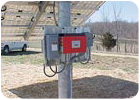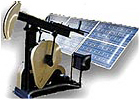Last month, we began a two-part series on solar pumps. We started with a review of solar energy, followed by a brief description of the various methods of converting solar energy to mechanical energy for pumping, and finished with a brief look at photovoltaic (PV) panels.
In this month's column, we will conclude by exploring the various types of solar-powered pumps available on the market, as well as some sizing considerations.

Alternating or Direct Current
The first decision you'll need to make is whether to go with an AC or DC pump. AC pumps for solar applications are the submersible-type used in conventional AC well applications. They are powered by a PV array using a device called an inverter (see Figure 1), which converts the DC power produced by the solar panels into 60 HZ AC power to run the conventional AC submersible pump motor. The advantage of using AC pumps is that they are relatively inexpensive, reliable, require minimal maintenance and are readily available. The disadvantage is they produce less water per square foot of PV panel because of the losses in the inverter.In an AC pumping system, the PV panels normally would charge a bank of batteries and run the pump and other equipment indirectly through the batteries and the inverter. Industry experts suggest using AC pumps when you have other uses for your PV array, such as lighting and powering other household devices like TVs, etc. Otherwise, they recommend using DC pumps.
A DC pumping system uses a DC motor on the pump, and usually runs the pump motor directly from the PV array. Running directly from the solar array means pumping only during the day, so if your application requires water during non-daylight hours, you will need to pump from the ground into a storage tank, and use gravity or another pump to get the water from storage to the point of use. A DC pump also can be operated in conjunction with batteries, like an AC/inverter system, but it is more efficient to run directly off the solar panels unless you have other uses for the solar-generated DC electricity. A direct DC system typically would use a special current boosting controller, which gives the pump a little boost for starting and allows it to run in low light conditions, extending its pumping capacity.
The advantage of using DC pumps, as we have said, is efficiency - more water pumped per day per square foot of PV panel. Their disadvantage lies in the fact that DC motors require routine service in the form of brush replacement. (Brushless DC motors are available, but they require much more elaborate electronics, so brush-type DC motors usually are preferred.) Brushes need to be replaced every five years or so, and you will have to pull your submersible pump in order to do it. Fortunately, solar submersible pumps are not heavy and usually can be pulled by hand, so replacing brushes is not a costly job.

Choosing a Solar Pump
There are a number of different types of solar pumps from which to choose. If you go the AC submersible route, you have hundreds of pumps from which to choose, from dozens of submersible AC pump manufacturers.If you go the DC route, your choices are somewhat limited. Several manufacturers offer DC versions of their 4-inch submersible pumps in a number of different models, to meet varying head and capacity requirements.
There also are several manufacturers offering DC submersible positive displacement pumps, which will lift water from as deep as 600 feet. Their capacity varies from 1⁄2 gpm to 4 gpm, depending on the lift. The shallower the well, the more water they will pump.
Another DC option, often taken when the water is more than 300 feet deep, is to use a solar powered pump jack (see Figure 2). If you have seen old rocking horse oil wells, you have seen a pump jack. They look like a rocking beam with a rod attached to one end, and a large concentric flywheel driven by a DC motor on the other end, providing the up and down motion. The rod extends down into the well to the pumping level, where it is coupled to a cylinder and piston assembly like the ones described in our articles on windmills and hand pumps several months ago.
If you have a pumping application located beyond the reaches of the electric power grid, you should consider using solar energy. Your experience installing standard AC submersible pumps will take you well down the road toward becoming a competent solar pump installer. ND

Report Abusive Comment